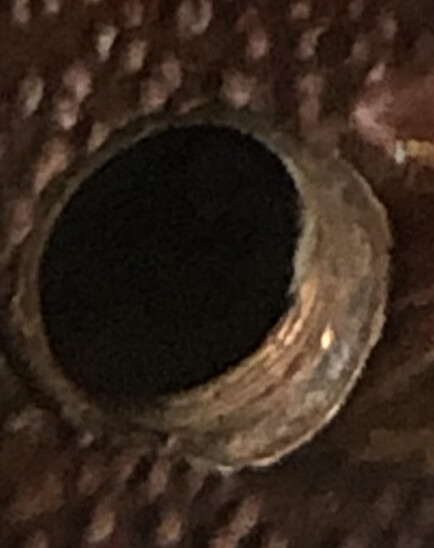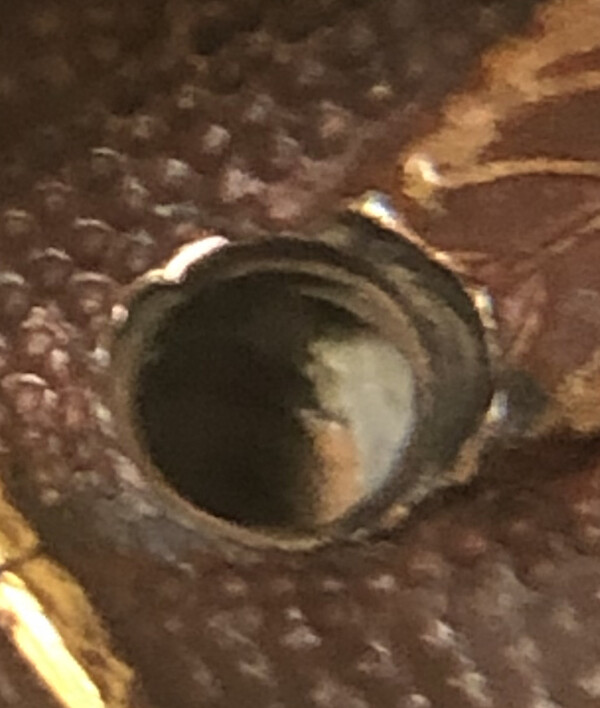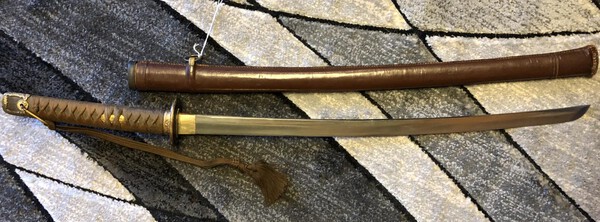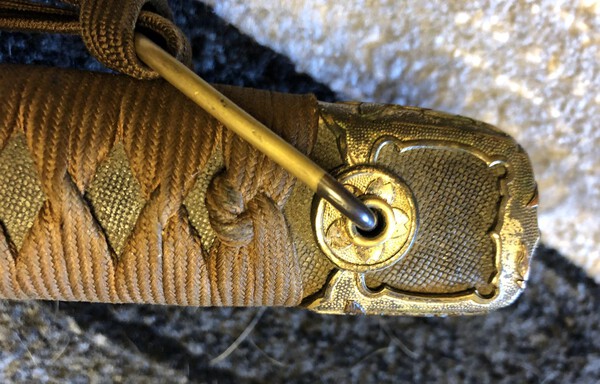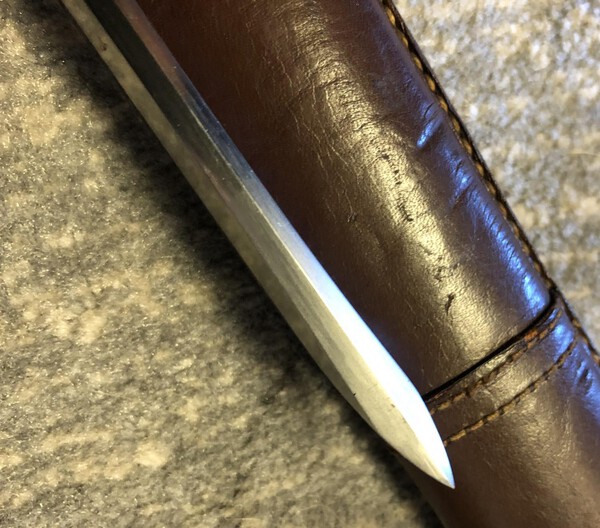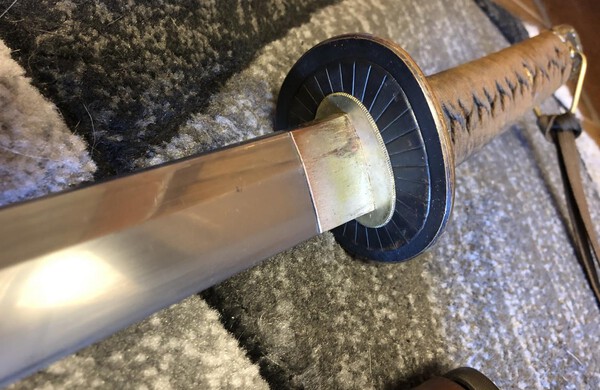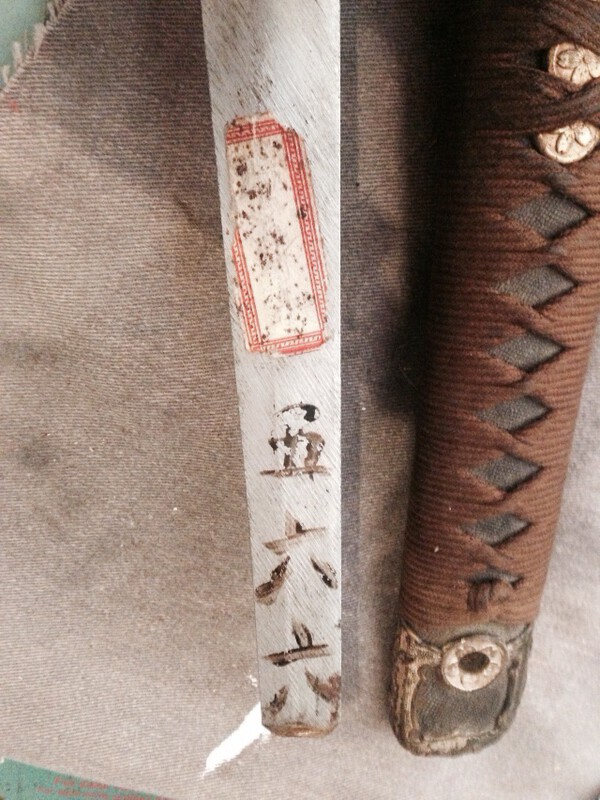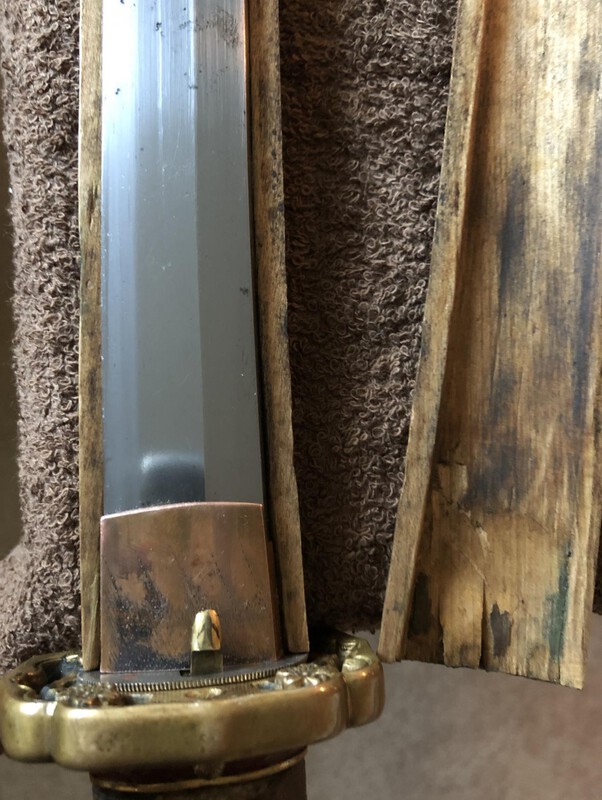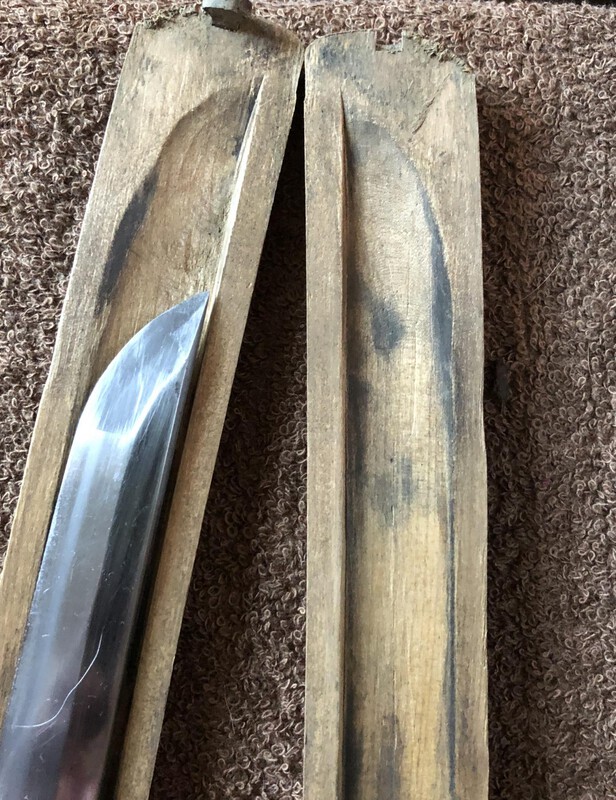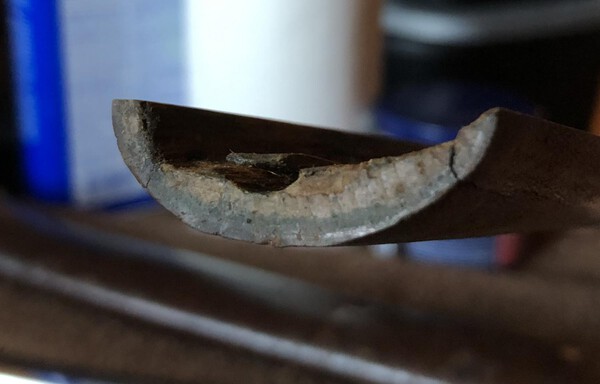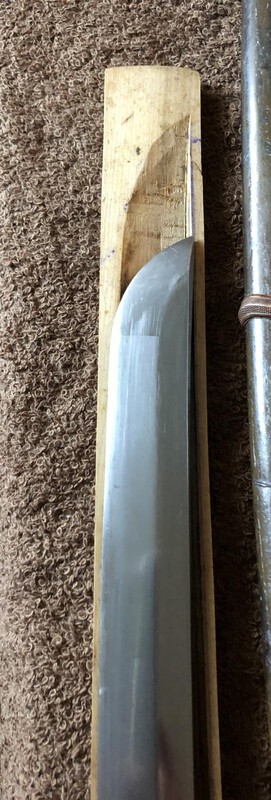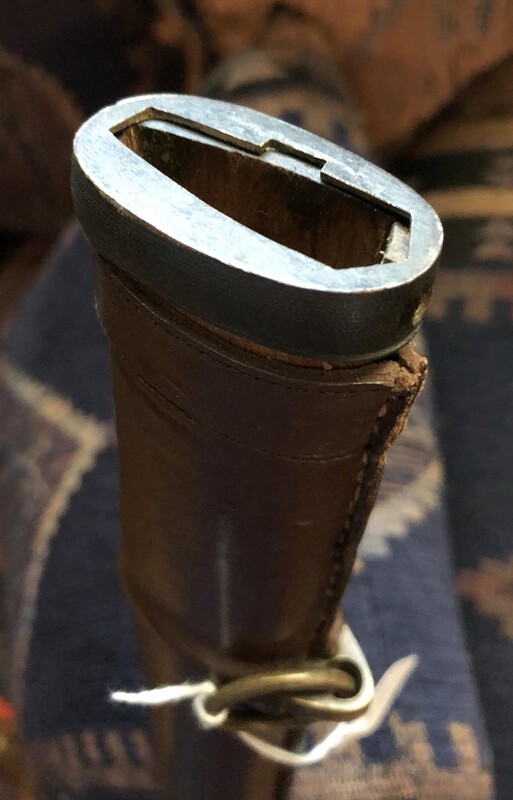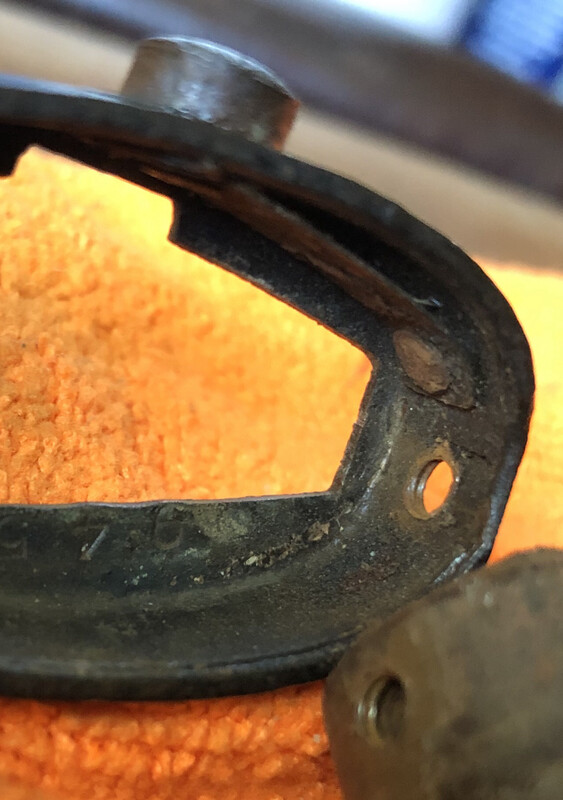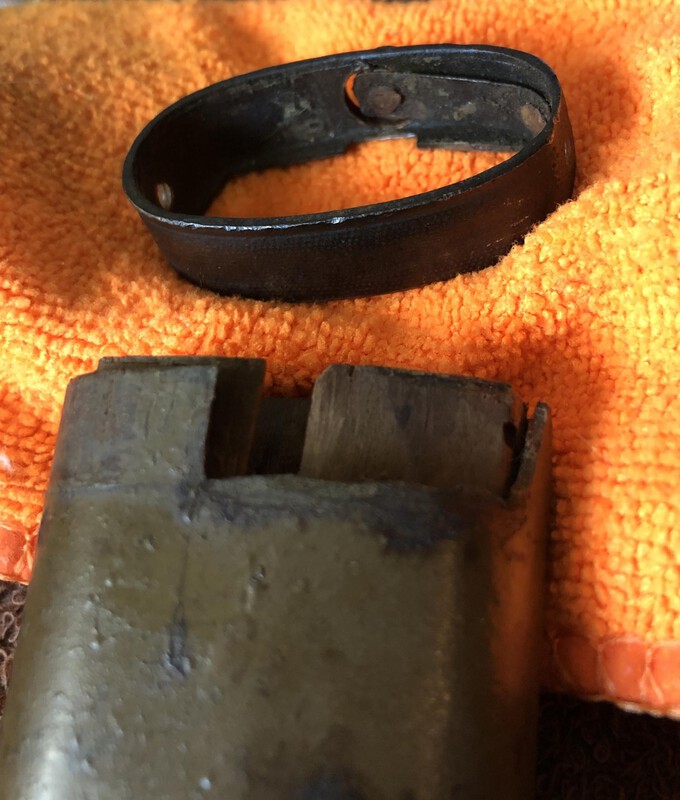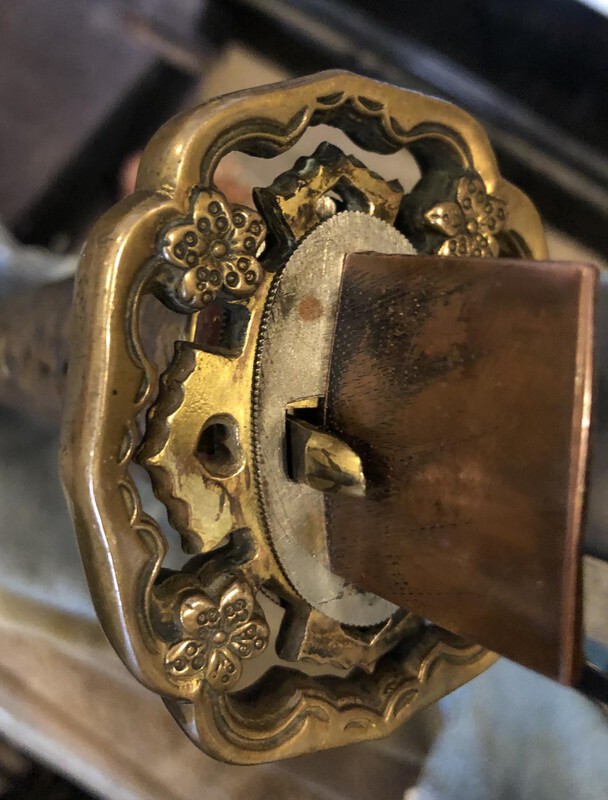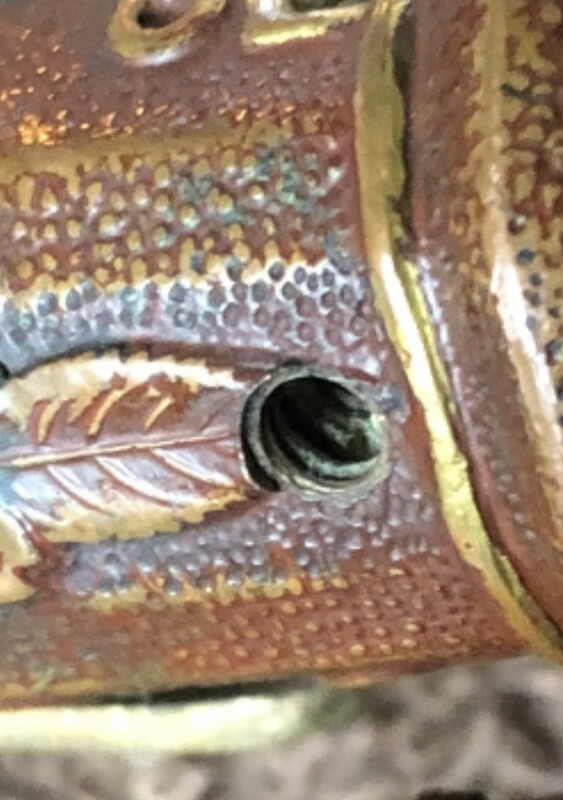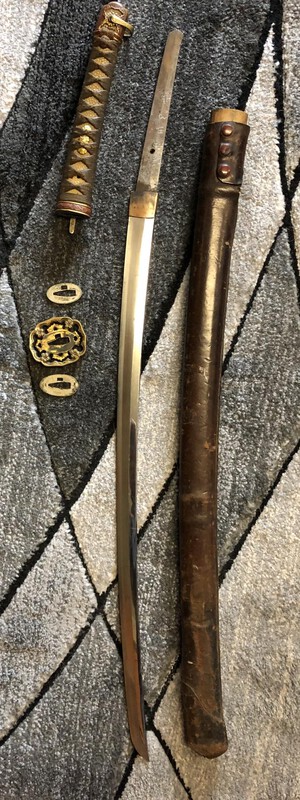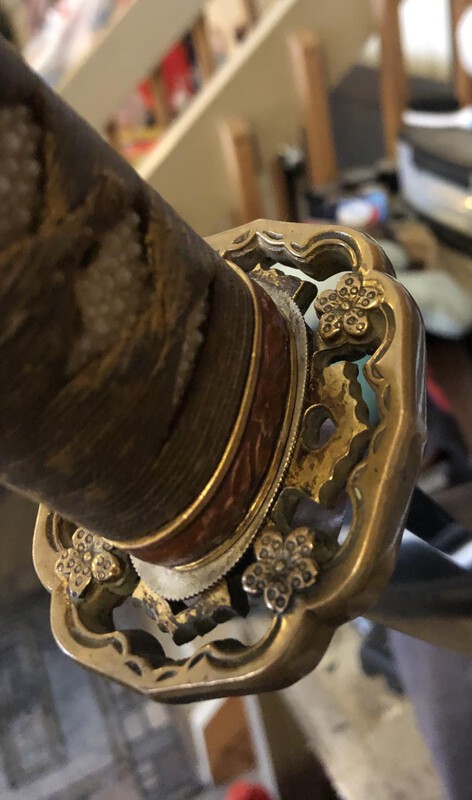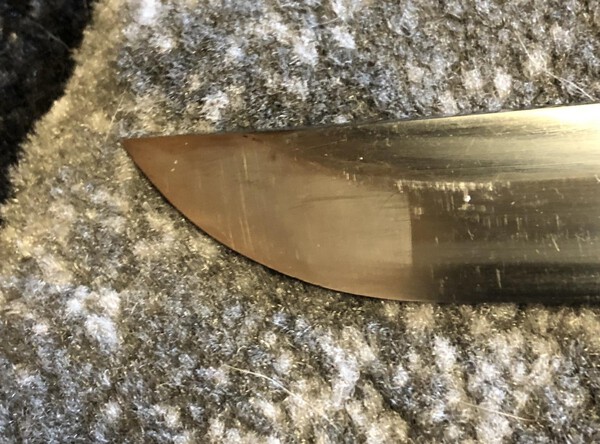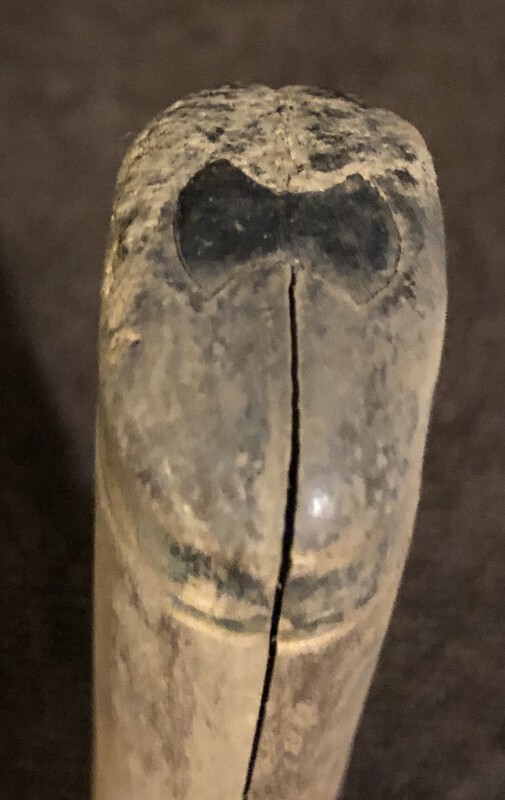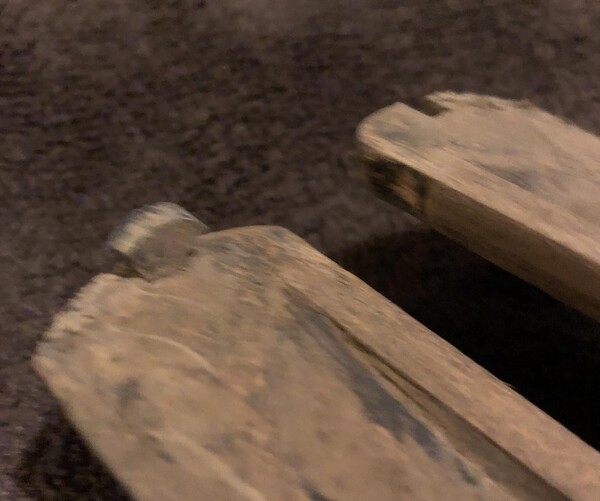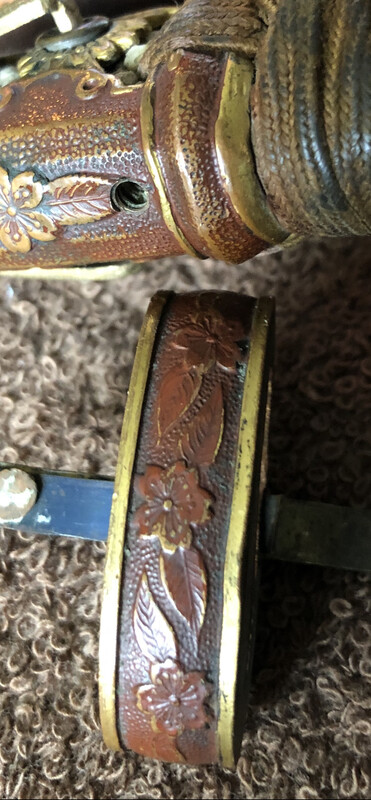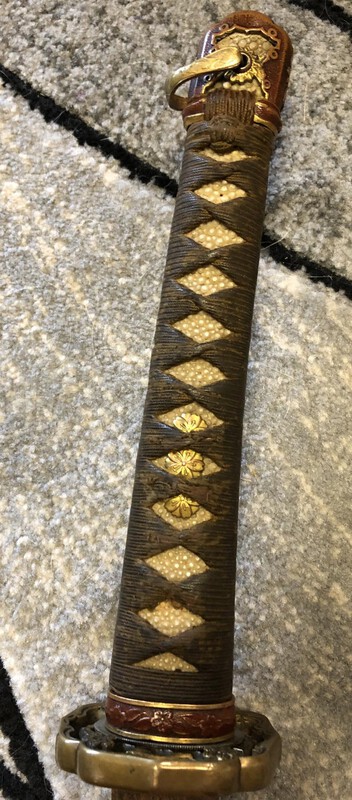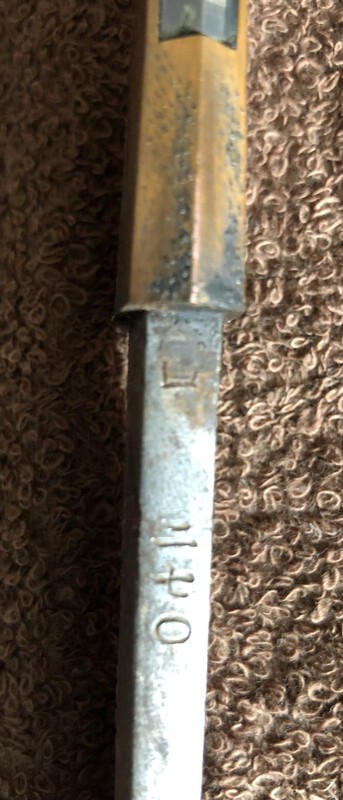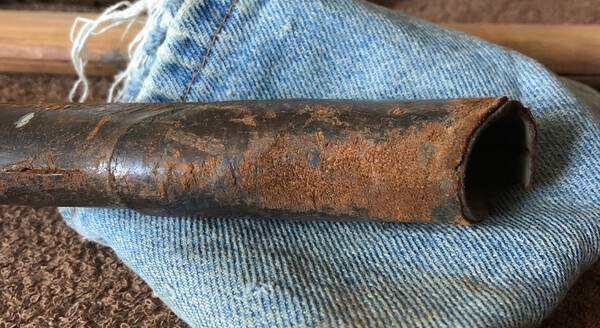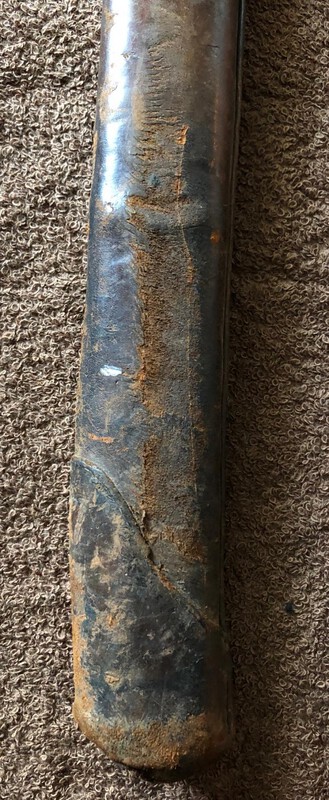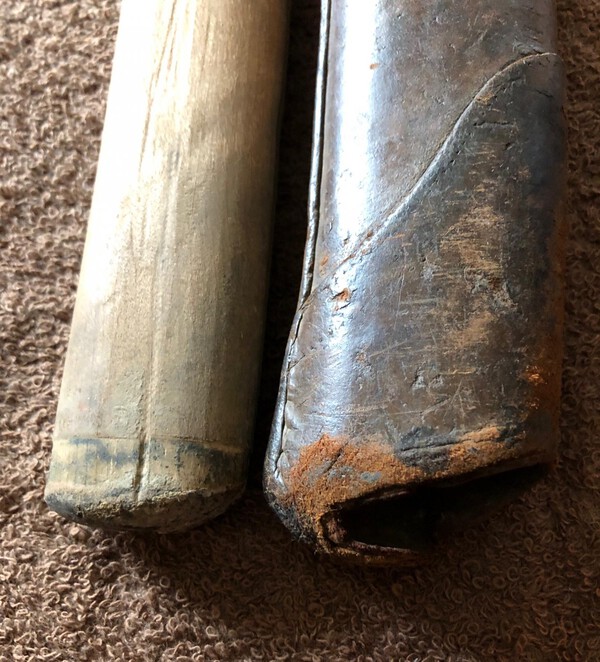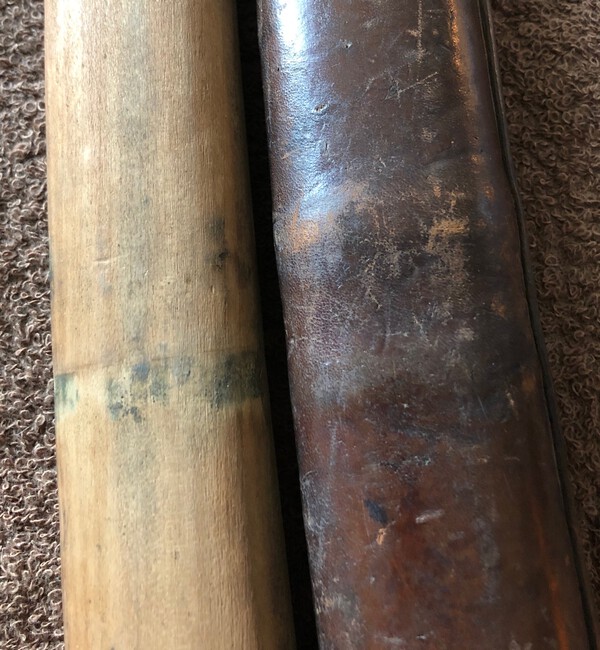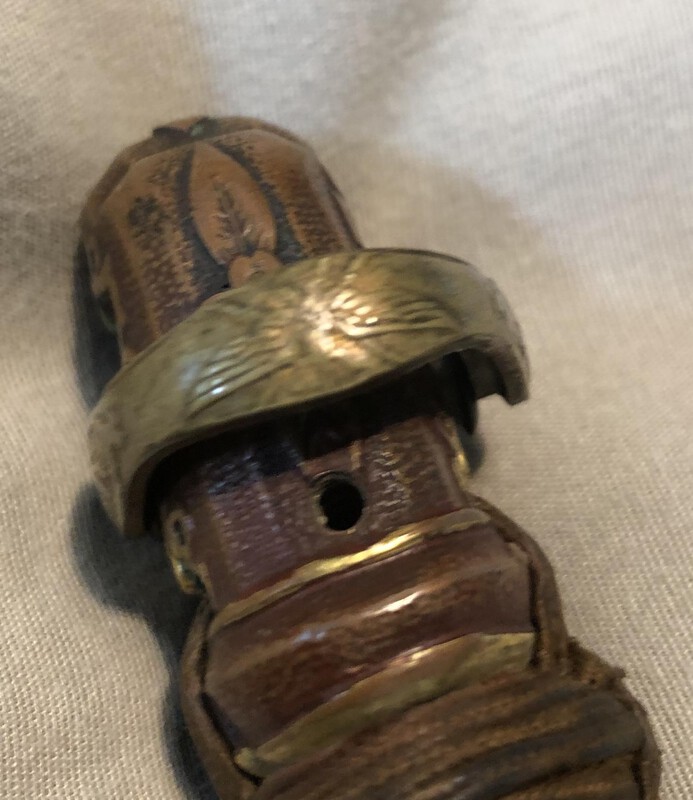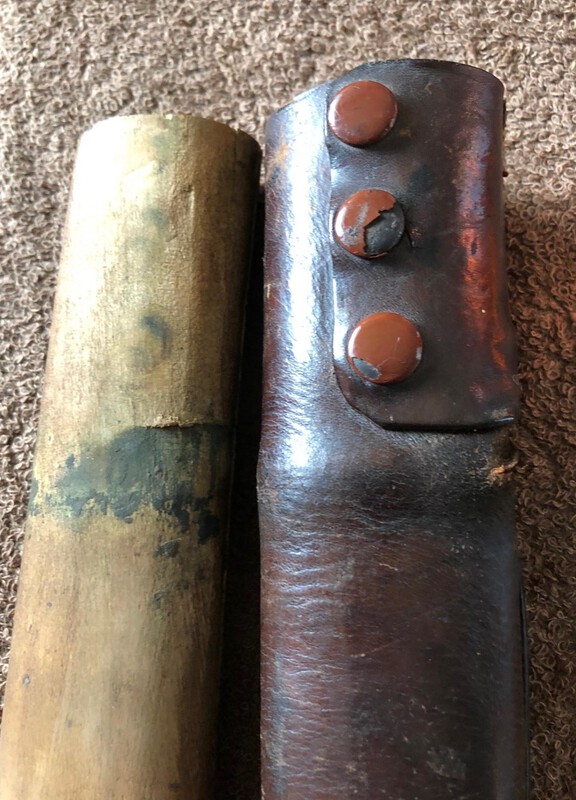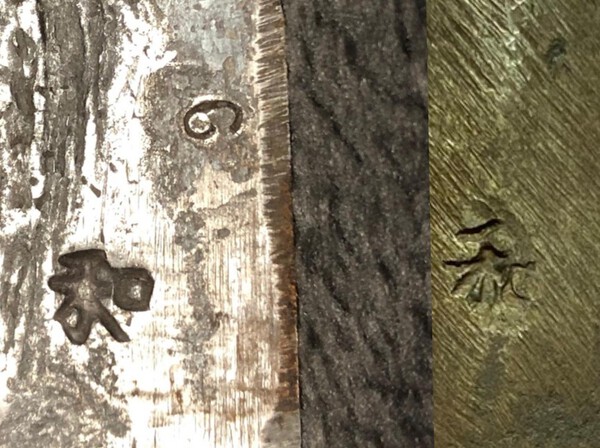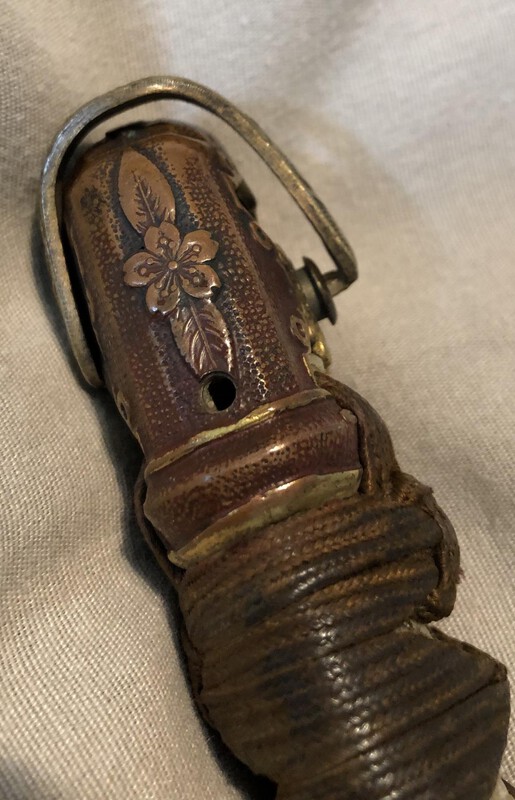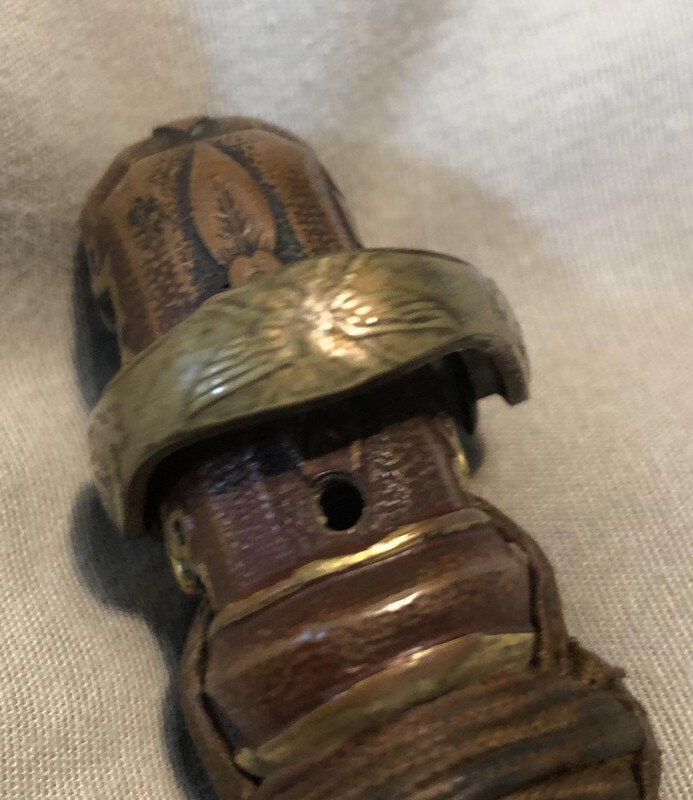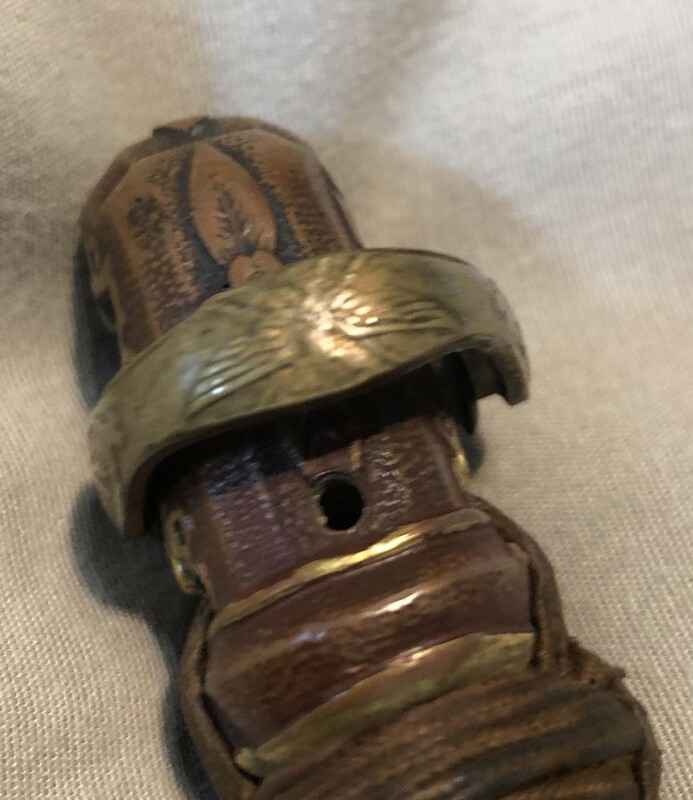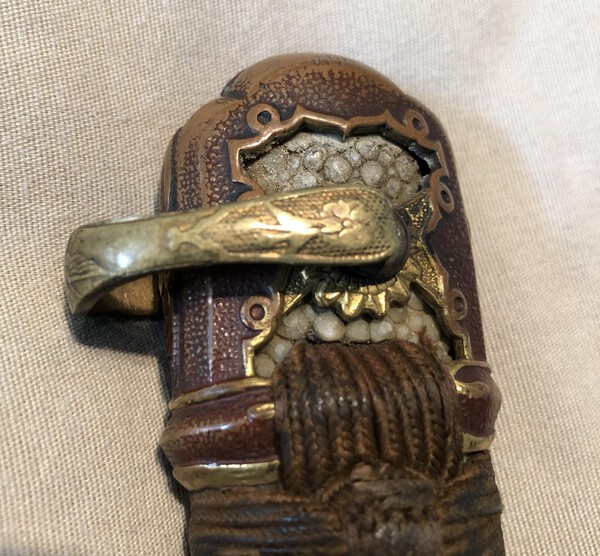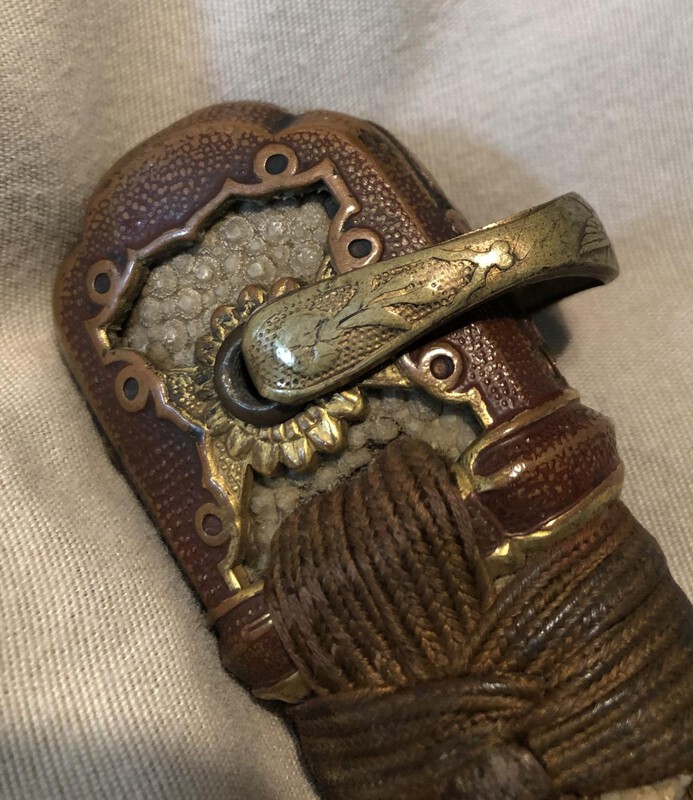-
Posts
13,018 -
Joined
-
Last visited
-
Days Won
155
Content Type
Profiles
Forums
Events
Store
Downloads
Gallery
Everything posted by Bruce Pennington
-

Does Curiosity Kill the Cat?
Bruce Pennington replied to Bruce Pennington's topic in Military Swords of Japan
Well that makes sense! It’s the only 2-button I’ve ever owned and I’d never taken it apart, so I never knew. Well, there’s another cat killed!! Ha! MRS is short for Manchurian Rinji-seishiki: http://www.militaria.co.za/nmb/topic/31767-manchurian-rinji-seishiki-sword/ -
I can't tell, Neil. Even magnified, I can't tell if I'm seeing threads or just two layers of something in the hole. My gut says it's threaded.
-
Dang, you guys just blew me out o' the water! I've never seen this before (if I have don't remind me, let me enjoy this!!! Ha!) Here's the link to the thread Chris is referencing: http://www.militaria.co.za/nmb/topic/30677-navy-rinji-model/?hl=%2Bnavy+%2Brinji Here's the description provide by Nick: "the navy also issued a "Last Ditch" Rinji spec directive for officer swords on 27th March 1945. Directive Number 54 said "1: Gilding, Gold Colored Metal and Cherry branch engravings are to cease, 2:Sarute not to be attached, 3:Only one Haikan (scabbard ring) to be present, 4: Use of animal skins to be minimized, 5: Push button type locks to be changed to tie-cord type, 6: Scabbards to be wrapped in tree bark and be finished with black lacquer." All of these on this post appear to fit the description! Wow!
-

Does Curiosity Kill the Cat?
Bruce Pennington replied to Bruce Pennington's topic in Military Swords of Japan
Wow Neil, I can't believe I have a koshirae item you don't already have!!! (or maybe you just don't take your saya apart? This is on a 1945 standard Rinji seishiki model (well it's got a star-stamped gendaito in it; but it's not the MRS 1945, just the "normal" kind.) -
Matt! That’s exactly in the right place as the one I have.
-

Does Curiosity Kill the Cat?
Bruce Pennington replied to Bruce Pennington's topic in Military Swords of Japan
Bruno & Chris, thanks. Yes, I suspect that might be true with the demands placed on the industry to crank these out en-masse. Bruno, it's unsigned, but the blade is clearly a Takayama-styled blade - short with bulbous kissaki: -
Spun this off of the "Airborne" Sarute thread. We were chasing a different rabbit. Made some interesting discoveries while pursuing Neil's question of whether my latest '39 Mantetsu is a piece-together item. First the '39 Mantetsu: Since I had the liner out of the saya for cleaning/drying, I laid the blade in one half of the liner to see how it fits and viola: It's a "close" fit on the curve, but as you can see, the liner was made for a much longer blade. Now, I will have to inquire into liner-making to see if that was the norm, especially for mass produced WWII gunto, or find more examples to compare. You can see, per Neil's observation that the blade came with a chuso, but that point isn't conclusive as the koiguchi is missing, and the liner is actually cut out to fit the chuso. But since I started looking for other examples, I tried to open up the other two Mantetsu saya, but couldn't get the liners to budge. Hmph. I opened up a combat saya on my Takayama-to, and again viola: This fit was even WORSE! Both curve and length were visibly off. Then I noticed the koiguchi and it's made for a chuso, but the blade doesn't have one, nor is the liner cut for one. Another Harumph, because now that means that the combat saya for my Takayama-to isn't original. I had always been bothered by the new look of the leather, the pattern of the leather pieces didn't fit normal WWII style, and it was brown rather than Navy black. So, curiosity DID kill that cat! Then, I tried my Rinji-seishiki, with star-stamped Kunitoshi, but couldn't get the liner out. Oddly, it was dry inside and was loose, but still wouldn't budge, when I noticed a jiggling sound at the end of the saya. The ishizuki is pinned, with both ends peened, and it jiggles when I wiggle the liner! So appearantly, the pin must go all the way through the liner to the other side. Harumph. Thought for sure I'd fined a good custom example to see if the liner was fitted perfectly. In re-assembling the saya I noticed the chuso was quite unique! Neil, have you seen this before? The edge of the saya had actually been cut larger for the different chuso design.
-
They weren't cut away in Thomas' example, though. Differences with Thomas' and mine - his was punched in for the "pin" where mine looks drilled (though Neil's looks drilled, too). Differences in methods are easily explained by different shops, different techniques. But my key problem is the holes are on both sides of the kabutogane.
-
"No greater love..." Neil, "than a guy who lays down his Kai for his friends"! I think I read that verse somewhere? I scanned the Mon thread and there are some with mon much lower than yours. But it still doesn't make sense that the holes are on both sides. I'm sure I haven't seen a kabutogane with mon on both sides, have you? {but I fear we're side-tracking this great thread}
-

Attention Mantetsu Owners: A Survey
Bruce Pennington replied to Bruce Pennington's topic in Military Swords of Japan
Oh my Gosh! I just noticed the Maximum Ugly blossoms on that tsuba! I realize there were lots of variations from shop to shop, but this one would win 1st Prize at the Annual Ugly Tsuba Contest!!! Well, the rest of the tsuba is quite nice, actually, but THOSE BLOSSOMS!!! AHHH! A cat-scratch habaki, nice fuchi and kabutogane, then this. It doesn't make sense. Could this be a piece-together? -
-

Attention Mantetsu Owners: A Survey
Bruce Pennington replied to Bruce Pennington's topic in Military Swords of Japan
More pics. Odd there are no boar’s eye seppa. Handle is snug so there wouldn’t be room to add them. Interesting way the liner maker joined the end of the two halves together: -

Attention Mantetsu Owners: A Survey
Bruce Pennington replied to Bruce Pennington's topic in Military Swords of Japan
Just added a '39 Koa to the collection and study! It's in combat saya and has the "Kite" or "Airborne" sarute. Serial number ロ(RO) 270, our 2nd RO. Blades in good shape, but the saya looks like it was worn by a really short guy who litterally dragged it on the ground everywhere he went, and he must have covered some miles! The bottom edge of the leather is completely worn through. What puzzles me is the missing sarute, the metal bands mid-way down the saya (you can see the imprint on the wood and the bulge in the leather where they used to be) and some sort of metal end-cap on the wood (can see the imprint on the wood). I'm guessing the G.I. that brought it back must have disassembled it and failed to put those parts back together. The leather at the top of the cover is fragile and broken where the snaps come around. Nice fuchi and kabutogane with extra gold coloring at the edges. I have some pics now, and will post more when I can. I bought this to re-sell .... but I don't think that's going to happen!!!! -
Close-ups of the blade tip too. While we wait for more pics, I will say that at first glance, I'm leaning toward Chinese reproduction. I got suckered by one at an auction recently, and it has an almost identical stamp, posted below. What makes me hesitate, though, is that your nakago is much better made than the majority of Chinese fakes. In the case of my fake, the blades was made pretty convincingly, but the nakogo was horrible.
-
I have heard/read that some guys did that before turning their swords in at the end of the war, and it was my first thought too, but the hole is on BOTH sides of the kabutogane. Neil - I know I've seen this before. Is it you that has a similar kabuto with holes?
-
Got one! Came on a ‘39 Mantetsu in combat saya! Looks old and worn fitting the wear on the entire piece. Sarute isn’t painted like the rest of the fittings, which says to me that it was made by a different shop and added by the koshirae shop or the officer after purchase.
-
George - Interesting observation about the lengths! I hadn't noted it before, but now that you've pointed it out, it feels right from the ones I've seen. Especially the basic ones in the tan saya. That was interesting to hear about them not being in the Ausie battle theatres, too. Dave - YES, that's the graph, thanks! Now it's part of the thread. Name - I agree with you Brian, as long as those books are out there, and old threads exist, guys will always show up using various terms for it. It will always be one of the toMAYto - tomMAHto debates. Given time, the weight of community lingo will settle it.
-
That's correct Bruno. Ohmura's point, though, was that the initial production of the Contingency model was to field test proposed modifications to the Type 98. Once proven, it was the goal of those promoting the model that the modifications were to be permanently incorporated into the Type 98. But for unknown reasons, they never were, and the "temporary" model, "Rinji-seishiki", simply continued being produced as a stand-alone model, yet was never officially declared a "Type." Nick's revelations make the model sound like is was intentionally produced as a simpler and cheaper sword than the 98, and was a "contingency" modification. Either or both may have been true at the same time, but whichever the case, it was never accepted/declared a "Type", but was always considered a contingency model. Clearly some officers liked it so much they paid extra money to spice up the model and fill it with quality blades.
-
I also wanted to document, here, that is was a Japanese magazine article that first coined the term "Type 3" (Ohmura). There was a magazine the Army Dept used to release official statements, but his one, "Ranru" was just a magazine catering to antique lovers and no publication with any authority." (Nick Komiya) "A total of 300 issues of government gazettes were released in 1943, and only 4 issues out of that announced changes in the Army Uniform Regulations (Gunto was part of the uniform regulations). The 4 announcements were---- 1. 1st April 1943 Army Ordinance 23 regarding alternative materials allowed in uniform related production 2. 19th August 1943 Army Ordinance 66 regarding arm patch insignia 3. 13th October 1943 Edict 774 announcing the Type 3 uniforms 4. 10th December 1943 Army Ordinance 99 regarding further alternative materials allowed in uniform related production Thus all 300 issues for 1943 has been checked to verify the Type 3 Gunto claim, which only served to prove that there never was such a designation as a "Type 3" for the simplified contingency spec alternative to the Type 98 Gunto." (Nick Komiya) Ohmura, himself, recognized that the Rinji model did not make it into the 1943 Regulation changes.
-
NMB needs a good, dedicated thread to the "Type 3", Contingency model, Rinji Seishiki, Type 0, Type 100, and this is one that has a good title. There has been some good discoveries and much discussion since this thread began. The lion's share of it is on the follow threads at Warrelics: http://www.warrelics.eu/forum/Japanese-militaria/deflating-another-myth-type-3-army-officera-s-sword-expanded-version-584796/ and http://www.warrelics.eu/forum/Japanese-militaria/1945-rinji-seishiki-icu-ventilator-762330/ and http://www.warrelics.eu/forum/Japanese-militaria/legally-rebutting-existence-type-3-army-officers-sword-708745/ and http://ohmura-study.net/286.html (in Japanese. Google tranlate for details) The model was discussed earlier than 1938, but in 1938 orders went out from the Army (not an Imperial Edict, which would have created a "Type" designation) that had several proposed improvements to the Type 98, making it more durable in battle, and at the same time, making it cheaper (remember officers had to buy their own gunto). The model was considered temporary - 臨時制式 Rinji-Seishiki (Contingency Spec) - with the idea that battle-proven modifications would be incorporated into Type 98 design. In late '42 the order was drafted, went out in '43, to make this permanent (Ohmura's link). Ohmura discussed theories as to why it wasn't incorporated as an official Type, one being that the Emperor had already adopted, and worn, the standard Type 98 version and therefore couldn't be imposed upon to modify his stance. But no one knows. I personally think that by 42/43, so many units had been purchased, and variations in quality and style, from cheap to high-grade custom with RJT stamped blades, that there was no "incorporating the mods into the 98". It had taken on a life of it's own. Plus, though it was "temporary", the sword shortage was so great that there was no way the Army could afford to cut production of any model. But that is just me speculating. P.S. If anyone has that copy of the draft specs, showing the drawings of the mods, please post here!
-

Manchurian Rinji Seishiki Sword
Bruce Pennington replied to IJASWORDS's topic in Military Swords of Japan
For future readers that start here, and haven't followed the progression of Neil's investigation into this model, I'll re-post the following (current reference books speculated that this model is a "Home Defense" model created at the end of the war to prepare for Allied invasion.) I posed the question to Nick Komiya, at Warrelics, if he had any data, or documents, describing the "Home Defense model" sword mentioned in several reference books. His response can be found here: http://www.warrelics.eu/forum/Japanese-militaria/1945-rinji-seishiki-icu-ventilator-762330/ Realizing that some have trouble with links, the majority of his evaluation is here: "There is no chance that such a sword was made for civil defense units. Core members of civil defense were policemen and firefighters, but such personnel simply could not get swords, due to wartime shortages. This shortage got to the point of prefectural police chiefs receiving a nationwide memo dated 27th February 1945 saying that though huge efforts were being made to secure a supply of badly needed swords, no magic solution was in sight and that the only immediate remedy was to ask retired police and fire brigade members to hand in their swords for use by incumbents, should they still have them. On the civilian front, the standard weapon of choice for Homeland Defense was the stereotype of sharpened bamboo poles, and there certainly was no plan nor intention to arm civilians with swords. What Bruce is calling a Homeland Defense model can only be a last ditch effort to continue the Rinji Seishiki effort. As I already explained here, the heavy bombings of 1944 basically killed off the sword industry by spring of 1945. Manufacturing within Japan was in the process of evacuation and relocation to a remote area outside the normal target areas. Reflecting this huge disruption to production efforts, two new weapon names suddenly appeared in the production volume plans for 1945 as published in May of that year. Those weapon names were 簡易銃剣 (simplified bayonet) and 簡易小銃 (simplified rifle). In the remarks column, the spreadsheet says of the bayonet “Without restricting the material or design, it should be outright simple, just enough to stab and hack with” Production planned for 1945 was as many as 1,200 thousand units. Remarks for the rifle said “Enhanced independence of the production locale”. When spelled out fully, that would mean “to get things done under one roof as much as possible without relying on parts suppliers all scattered around”. They had planned to put together 15,000 of these rifles. Both these simplified weapons were officially approved for production on 14th May 1945. When mainland production was in such a stage of grasping at straws, continental facilities like Jinsen and Nanman were safe havens away from all the bombing, but unlike before, they no longer had the luxury of job distribution possibilities with the mainland and had to produce everything locally, lock, stock and barrel. I am not enough of a sword fan to know how Mantetsu split jobs with mainland companies, but if they had been relying on Japan for the Koshirae, the tide of the times would have required all that to be Manchurian sourced as well. If they said of the bayonet "Never mind what it looks like or what it's made of, so long as it stabs and hacks", a Mantetsu blade with duct tape as Tsukamaki would have easily made the grade. Is that to be regarded as a new model? It would be more like the the Rinji Seishiki taking its last free breath before going on the ventilator." -

Manchurian Rinji Seishiki Sword
Bruce Pennington replied to IJASWORDS's topic in Military Swords of Japan
-
You'll find more guys with a much broader translation expertice at the Translation Assistance thread: http://www.militaria.co.za/nmb/forum/15-translation-assistance/
-

Attention Mantetsu Owners: A Survey
Bruce Pennington replied to Bruce Pennington's topic in Military Swords of Japan
That’s not a bad idea, Trystan. The chart is for 1944 and these are ‘45 blades, but they easily could have been. -

Attention Mantetsu Owners: A Survey
Bruce Pennington replied to Bruce Pennington's topic in Military Swords of Japan
I agree, Trystan & Neil, that your wavy hamon Mantetsu blades are legit. But both are modest. That one on Ohmura's example is more like the blades coming out of Japan, via Komonjo, that are far more extravegant, and therefore, suspicious. It may turn out that they're all legit, but I believe the ones you guys own without question. Admittedly, Ohmura did not claim his example was a Mantetsu, but like Neil's point - all the known, in-hand, examples we know of are. So, that makes his an outlier.


